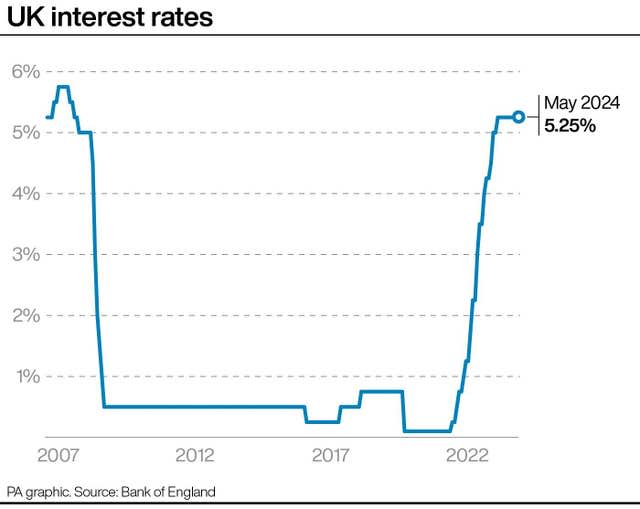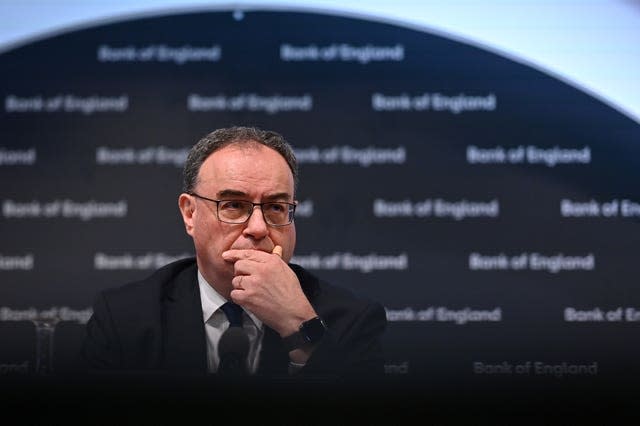
The Bank of England has said it is not ruling out cutting UK interest rates next month, after deciding to hold borrowing costs at the same level for another month running.
The Bank’s Monetary Policy Committee (MPC) said it was not yet at the point where it can start cutting rates, opting instead to hold them steady at 5.25%.
But Governor Andrew Bailey said he was “optimistic that things are moving in the right direction”, with inflation set to fall to its 2% target between April and June.
He said: “Before our next meeting in June, we will have two full sets of data – for inflation, activity and the labour market – that will help us in making that judgement afresh.
“But, let me be clear, a change in bank rate in June is neither ruled out nor a fait accompli.”
It means there is no certainty of a rate cut but the committee could be swayed by upcoming datasets if they provide enough evidence that inflation has reached the target level, and it is going to stay there.
Chancellor Jeremy Hunt said he would “much rather” policymakers “wait until they are absolutely sure inflation is on a downward trajectory than rush into a decision that they had to reverse at a later stage”.
But he added that it was encouraging to see “real optimism” from Mr Bailey for the first time.


Mr Bailey also indicated that the financial markets are more pessimistic about when interest rates will be reduced than the Bank of England.
“With the progress we’ve made, to make sure inflation stays around the target, it is likely that we’ll need to cut bank rates in the coming quarters, possibly more so than is currently priced into markets,” he said.
But he stressed that the committee has “no preconceptions” about how far and how fast it can lower interest rates, and it will make a judgment based on the economic data it sees before each meeting.
In a stronger signal that the tide is turning among the rate-setters, two members of the Bank’s nine-person MPC voted for interest rates to be cut by 0.25 percentage points, to 5%.
The MPC members, Swati Dhingra and Dave Ramsden, felt Consumer Prices Index (CPI) inflation is already on a firm downward path and there is no need to delay reducing borrowing costs.
But the rest of the committee signalled it is still looking for stronger evidence that certain indicators putting pressure on inflation have eased.
These include wage growth and services inflation, which remain relatively persistent.


Meanwhile, the Bank of England slightly upgraded its forecast for UK economic growth.
In its latest Monetary Policy Report, it said gross domestic product (GDP) will increase 0.5% this year and 1% in 2025, both 0.25 percentage points higher than the last estimates published in February.
The improved outlook reflects higher estimates for population growth, which will boost productivity, as well as energy costs coming down.
It also expects some positive impact from the Government’s recent tax cuts, which is set to boost GDP by more than 0.25 percentage points compared with February projections.
Over the next few years, CPI inflation is expected to fall to a lower level than prior predictions, dropping below-target to 1.5% across 2026.
In the shorter-term, CPI is set to hit the 2% target between April and June, before rising to 2.6% by the end of the year.
There are some risks to the forecast, including geopolitical tensions intensifying amid conflict in the Middle East, although this has so far had a relatively limited impact on trade and oil prices, according to the report.
George Buckley, chief UK and European economist at Nomura, said it sounds encouraging that inflation will eventually be lower, but it means it could end up going below the target level based on the current expectations for interest rates.
“The Bank of England does have a job to do and it has to achieve the 2% target,” he said.
It means that the Bank could decide to cut interest rates by “more than what markets are pricing” if it wants to achieve that balance.






